Menu
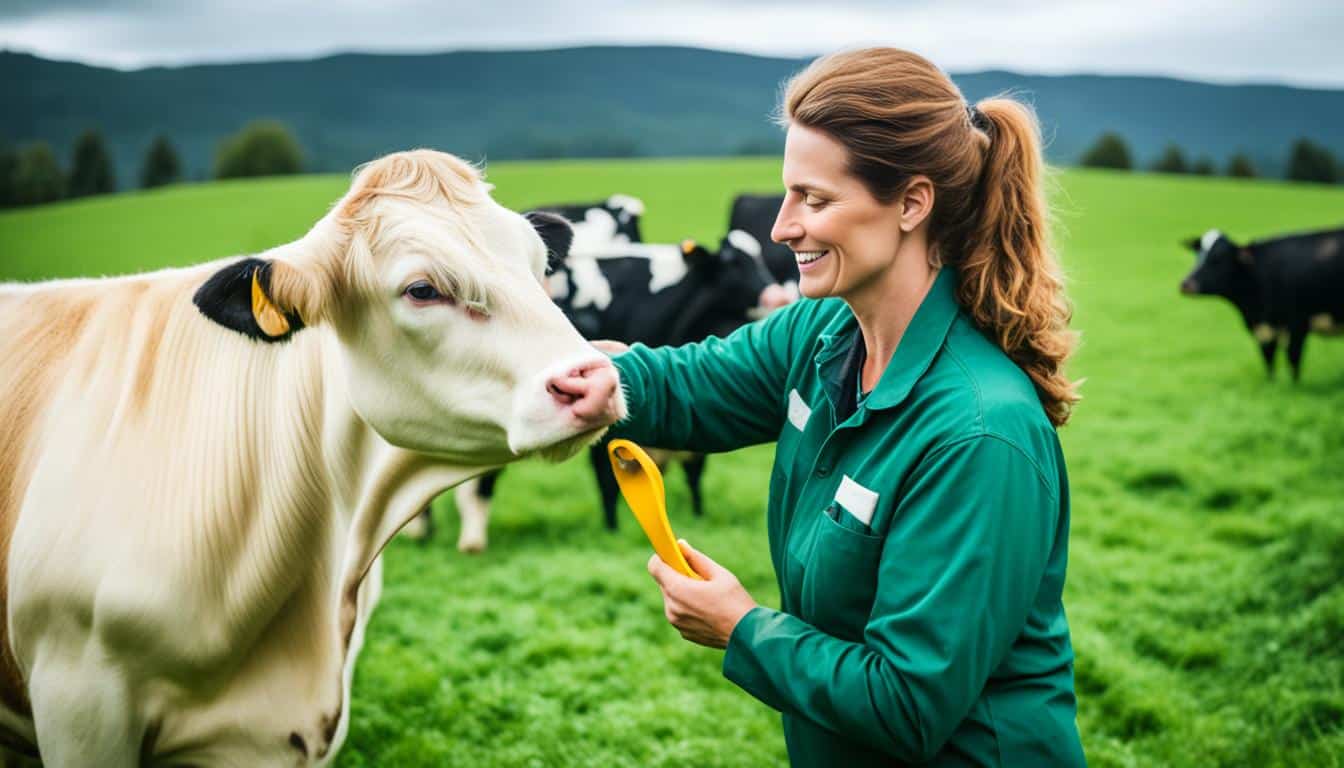
Did you know dairy cattle can start feeling stressed in mild heat over 72°F with 50% humidity? This shows how tough it is to manage livestock stress. Many things like injury, changes in the environment, and meeting new people can make animals stressed. This stress makes them release adrenaline and noradrenaline, hurting their immune system and fertility. It also reduces farm productivity. To help animals cope better, good handling, proper facilities, and less stress from human contact are key.
Recognising and understanding livestock stress is crucial for animal welfare and farm productivity. Livestock stress can be either physical or mental. It leads to a state of tension which affects their immune function.
This stress can result in health problems for the animals. Many things can cause stress in animals. So, addressing stress requires looking at all aspects of their care and environment.
Stress in animals occurs when something upsets their natural balance. This could be due to physical things like transport or psychological factors. For example, too much of the stress hormone cortisol can lower reproduction and make animals more prone to diseases.
Research shows that how we handle and manage animals affects their health. For example, badly planned movement of livestock can lead to health issues and lower reproduction.
Many things can make animals stressed:
Looking at these various stress causes shows us how to make life less stressful for animals. By making necessary changes, we can improve their welfare. This also encourages animals to act as they naturally would, which is better for them and the farm.
| Factor | Impact on Stress |
|---|---|
| Environmental Adjustments | Causes chronic systemic inflammation, leading to diseases. |
| Transportation and Restraint | Severely reduces immune function, causes embryonic loss. |
| Visual Distractions | Causes balking, disrupting movement and handling. |
| Diet and Nutrition | Impacts glucose metabolism, requiring chromium supplementation. |
| Facility Design | Reduces balking with uniform colours and proper layout. |
Stress is a big part of farming animals, but its effects on their welfare are huge. It affects their health in many ways, from their immune system to the risk of getting ill. So, it’s vital to handle stress well to keep animals healthy and productive.

Stress badly affects how well an animal’s immune system works. According to research by Cooke et al. in 2012, stress lowers feed intake and stops the body from making helpful hormones. This makes an animal more likely to get ill. A weak immune system means sickness can spread fast among animals, harming their health.
Animals become more prone to diseases when they are stressed. Scientists, like Lynch in 2010, found that stress raises certain harmful hormone levels. Johnston et al. in 2014 discovered that some animals handle stress better because of their genes. Even so, stress makes it hard for animals to fight off diseases, showing that reducing stress is key.
Dealing with stress is essential for animal welfare and more efficient farming. A study by Collier and Renquist in 2017 showed that stress affects not just single animals but the whole farm’s productivity over time. So, managing stress the right way is important for the animals and the farm’s success. This is good for business and the animals.
Actively looking for and managing stress in animals keeps them healthy. It results in happier, more productive animals and a better farm overall. This path improves both animal welfare and the farm’s success.
Good farm management should include ways to manage stress in animals. This helps make sure animals are treated well. One major step is to set up the area in ways that each animal type likes. This means making sure they aren’t too cold or too hot, have good shelter, and get enough fresh air. When we get this right, animals are healthier and happier.
It’s vital to keep animals at temperatures they like to stay healthy. If they get too hot or too cold, animals get stressed. Studies have shown that making their environment better can help fight off stress. Setting up the right buildings and using the right controls for the weather can make a big difference.
Animals need places that keep them safe from bad weather and let the air flow well. This includes using high-tech shelters and fans. These can make living conditions perfect, which makes animals less stressed. This, in turn, makes them healthier and more productive.
High-tech milking and grooming systems also reduce stress among animals. These systems limit the need for people to be around animals all the time. Research has shown that improving the animals’ surroundings can have healing and protective effects.
Improving the living space for animals from young to adult can reduce stress in rats. (Pena et al. 2009)
There are both money and well-being gains by improving animal living areas. This is proven by studies. By caring about how warm or cool it is, the type of shelters offered, and using the latest stress-busting methods, farms can do better. This includes making animals feel good and improving how much they produce.
Good nutrition strategies are vital for lessening livestock stress. Making sure their diets are just right and using extras like feed additives is key. Doing this well means happier animals and a more efficient farm.
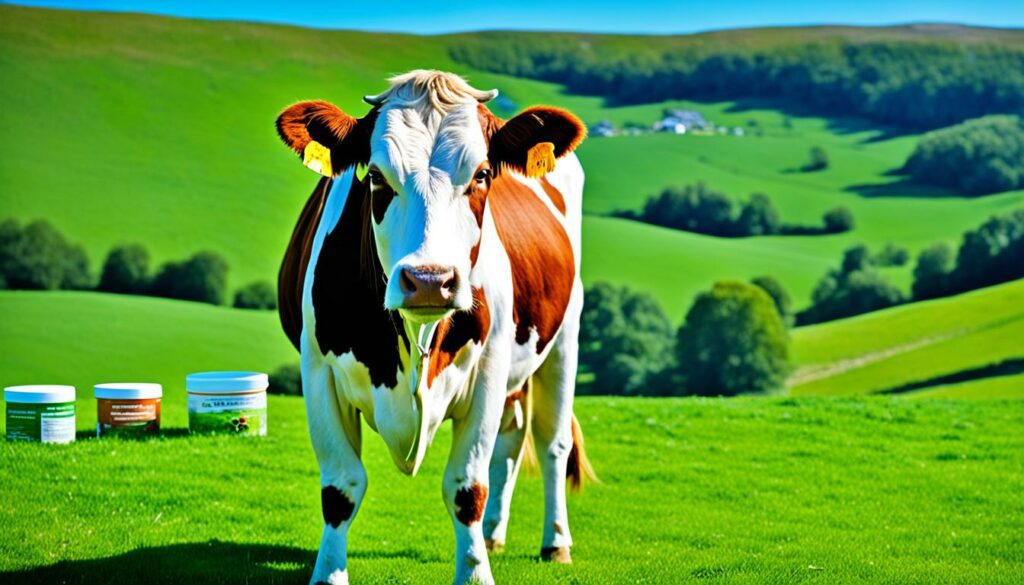
Making balanced diets is important for keeping livestock healthy. It helps them deal with changes in weather or their bodies without getting too stressed. For example, provide more food in winter to fight off the cold.
Changing their food slowly also stops problems like eating too much suddenly. This can help avoid issues with weight and digestion.
Adding things to their food can make animals stronger against stress. For example, tasty additives help with post-lactation diets by making food more appealing. Then, supplements for hooves support moving without pain, making them less likely to get hurt.
These extras not only cut stress but boost health and work output too.
| Nutrition Strategy | Purpose | Benefits |
|---|---|---|
| Balanced Diets | Ensure proper nutrient intake | Reduces stress, supports overall health |
| Season-Specific Feeding | Match nutrient needs to environmental conditions | Mitigates temperature-induced stress |
| Feed Additives | Enhance diet palatability and promote health | Supports immune function, reduces stressors |
| Gradual Feed Changes | Prevent abrupt dietary adjustments | Reduces risk of overweight and digestive issues |
Focusing on nutrition strategies in farm management is crucial for stress relief. By customising food and using the right additives, we can make a better place for our animals. This improves their lives and our farm’s success.
It’s key to use calm and efficient ways to handle animals. This can help reduce how stressed they get. By following known methods and using the right facilities, we make sure our animals are well taken care of.
Acting calmly and efficiently around animals is vital. Doing so can make them less worried, lowering stress levels. This benefits their health and makes them more productive, as they’re less likely to get sick from stress.
Many things can stress animals out, like being tired or not having enough to eat or drink. Stress can weaken their immune system and make them less fertile. By being aware of what stresses them and handling them with care, we can avoid these problems.
The right facilities are crucial for keeping animals calm. Things like curved chutes that hide the handler or automated systems can help a lot. They reduce the need for too much human contact, which is a common stress trigger.
It’s also important to feed animals well and look after their living conditions. This involves providing the right food for each season and ensuring they have enough water. A comfortable environment, like shaded areas, is a must. Such efforts make it easier for them to deal with changes.
Cattle see really well but have a spot they can’t see behind them. Moving them carefully, making sure areas are not too dark or too bright, helps. Training staff in gentle handling methods is also very important. It makes a big difference in how the animals feel and behave.
So, good livestock management includes proper handling that considers animal needs and uses correct facilities. These are key in running successful and stress-free farms. We get healthy, happy, and productive livestock by focusing on these things.
It’s vital to make sure livestock are familiar with people and have a set routine for their care. This can lower stress and make their lives better. Handling them regularly and keeping their care, like feeding, stable helps animals stay calm.
Starting early and gently with human contact helps animals behave well. They become less anxious and more trusting. This makes handling them easier, helping them and us be more productive.
The animals need to know what to expect each day. This means feeding them at the same times, cleaning their living space regularly, and avoiding big surprises.
Doing these things stops the animals from getting too stressed. They look forward to their routines, like knowing when they’ll be fed.
| Factor | Effect on Livestock | Solution |
|---|---|---|
| Inconsistent feeding schedules | Heightened stress and anticipation | Implement fixed feeding times |
| Sudden changes in environment | Increased agitation and anxiety | Gradual acclimatisation |
| Lack of early human interaction | Fear and resistance during handling | Early and gentle exposure to handlers |
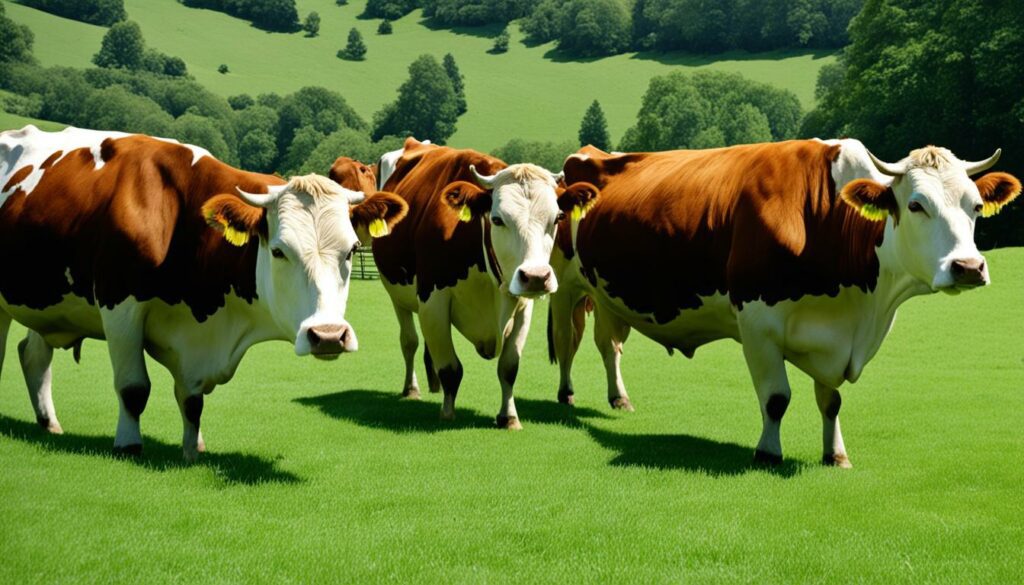
Using solid chutes and keeping lighting steady are also key. It makes handling less scary for animals. By starting early with human contact and keeping things stable, we help animals feel less stress and be happier.
Times like weaning and lactation can be tough for livestock. It’s key to manage them well to keep the animals healthy. Good farm techniques and making their environment better can really help reduce stress during these times.
When weaning, young livestock, like piglets, can get stressed. It’s important to watch what you feed them. Keeping proteins at 13-15% in their diet helps with growth and staying healthy.
Start with only 1% of grains compared to their weight. Slowly, you can add more. Feedings should be twice daily. This routine helps keep their eating habits regular. So, they gain about 1.5 to 2.5 pounds a day, growing strong and healthy.
Nursing sows have high nutritional needs. Careful feeding keeps them healthy and productive. For growing steers, feed around 1 to 1.5 pounds of grain per 100 pounds of weight. As they near the end of the process, this goes up to 2 to 2.5 pounds.
It’s important not to add more than 10% grain too quickly. This prevents digestive problems and helps manage their weight right. A good diet mixes grain and hay over 45 days to make sure they’re eating well.
Always give them fresh, clean water, especially when it’s hot. This helps their food intake and keeps them well. It makes things easier for them and, in turn, for the farmers too, leading to healthier livestock.
Improving where they live, like better housing and proper airflow, plus keeping good records, is a complete plan. Feeding steers apart helps to watch what each one eats. This is very important during these delicate phases.
Good healthcare for animals means being gentle and using proper pain control. These ways help lower the bad effects of getting medical help. This makes the animals less stressed and their welfare better.
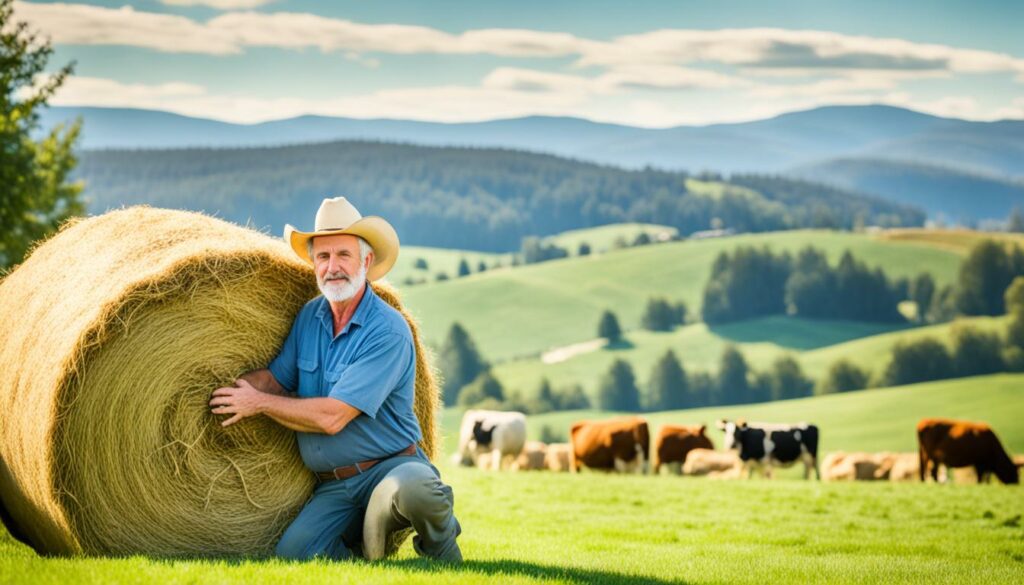
Being gentle is key when dealing with animals for their health. It includes moving slowly, talking quietly, and using tools that don’t hurt them. Doing this reduces stress hormones. It means the animals will behave better and be healthier over time.
Hurting less means stressing less. Using medicine to numb pain during treatments helps a lot. It stops chronic pain from making the animals more stressed. This way, they can get better quicker and stay healthy and productive.
These methods make animal health care better and ensure the animals are well looked after. Proper care and pain relief at the farm not only helps the animals but also makes work better for those looking after them. This is the best approach for keeping stress low for everyone involved.
It’s crucial to handle heat stress in livestock well to keep them healthy and productive. Dairy cows are particularly at risk as heat can cause them to have health issues and change how they behave.
The Temperature Humidity Index (THI) helps us know how stressed cows are. A THI of 75 and a slight breeze make a cow that normally produces 100 pounds of milk breathe quite fast. This means they’re feeling the heat a bit too much.
It’s important to watch their breaths because normal for cows is lower, between 40 and 60 breaths a minute. If over 10% of cows breathe more than 100 times a minute, it’s a sign something is wrong. Also, checking their temperature is a must – it should be between 101.5 to 102.5 degrees Fahrenheit. If over 5-10% of cows have a higher temperature, it’s an emergency.
There are several ways to help cows cope with heat stress, including managing how they feel and improving their environment:
| Heat Stress Level | Milk Production Decrease (lbs./head/day) |
|---|---|
| Mild | 2.5 |
| Mild to Moderate | 6 |
| Moderate to Severe | 9 |
| Severe | 10+ |
In summary, using these methods to manage stress and improve the cows’ surroundings, we can lower heat stress. This leads to happier and more productive animals.
Every year, millions of cattle face stressful journeys. This can be the most distressing experience in their lives. But, with good farm management, we can make these trips less scary for them.
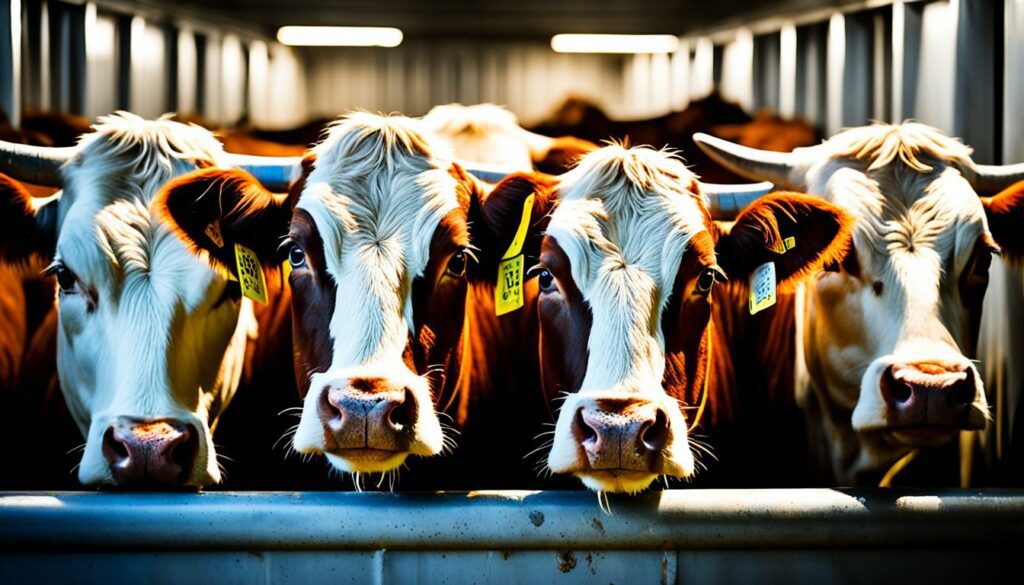
Before moving animals, preparation is key. Use top-notch facilities and skilled workers to load and unload them. Weaning calves more than 45 days before shipping also helps. This reduces stress, especially in young cows.
It’s vital to keep trailers clean and the air fresh. This lowers the chance of diseases while travelling. Paying close attention to the weather is a smart move too. It helps reduce stress even more.
When animals reach their new home, they need time to get used to it. Giving them rest and lots of care can lower their stress. A careful feeding plan prevents a bad ‘yo-yo effect’ on their health.
Managing feed well also supports their health in the long run. This shows how important it is to handle livestock with care.
provides more details on best practices.
| Key Action | Benefit |
|---|---|
| Utilise well-designed facilities | Decrease stress during loading and unloading |
| Weaning calves 45 days prior | Significantly reduces stress levels |
| Maintain sanitation and air quality | Reduces the risk of disease |
| Plan transportation based on weather | Minimises stress caused by temperature fluctuations |
Using these strategies makes for better animal care. It ensures livestock travel more comfortably. This, in turn, leads to effective and caring farm management.
In the world of livestock, new technologies are making a big difference. They help make animals happier and farms work better. For example, we have machines like automated milking robots and automatic brushing systems.
Automated milking robots are changing how we dairy farm. These machines let cows get milked when they want, cutting down on stress. This means less handling by humans, which cows like.
These robots also keep cows’ udders healthy with their precise milking. That’s good for the cows and the farmers. And it all helps make the farm run smoother.
Then there are automatic brushing systems. They allow cows to groom themselves, which is good for their health and mind. Cows can brush themselves as they need, reducing the anxiety of being handled by people.
These systems are not just about physical health. They also help cows feel better mentally. They are a key part of making farms friendlier for animals, through both health and happiness.
| Matter | Outdoor Temperature | Temperature Under Cow |
|---|---|---|
| Sand | 92°F | 97°F |
| Manure Solids | 75°F | 98°F |
| DCC Waterbeds | 87°F | 84°F |
| Traditional Flat Cow Mattresses | 89°F | 97°F |
Using these technologies is key to helping animals on the farm. They reduce stress, keep the animals well, and make farming more efficient and kind.
Good farm management is key to keeping livestock stress low. It involves looking at the surroundings, what the animals eat, and how they’re taken care of. By looking after these things, animal happiness gets better, and the farm does well too.
“Livestock may get stressed from being tired, hungry, or in new places. Stress is bad for their health and can reduce how well they eat, have babies, and work.”
One big part of managing a farm well is understanding animal behaviour. Animals that know humans from when they’re very young aren’t as scared or stressed later. This makes it easier to look after and move them without scares.
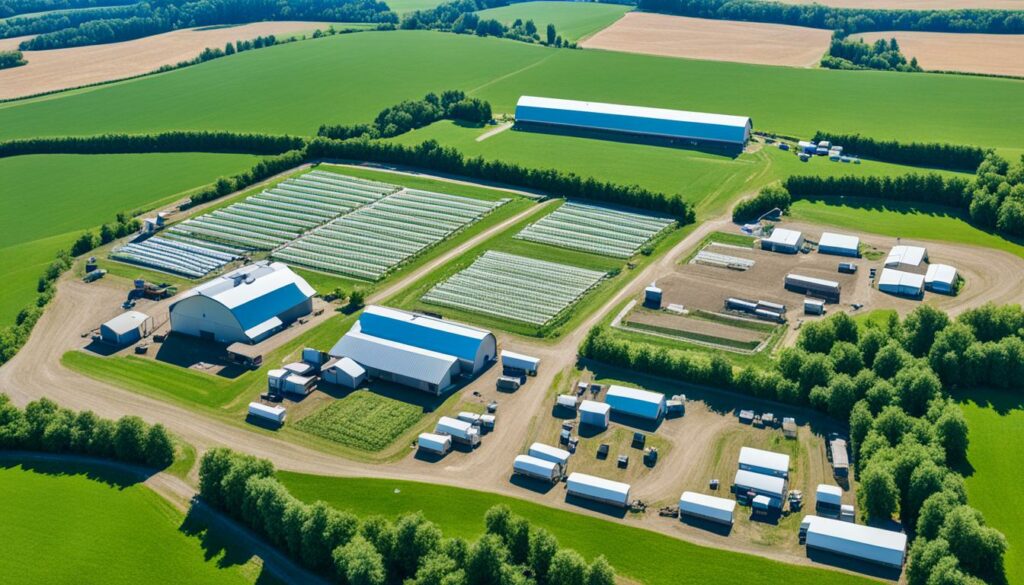
Helping animals eat right is also important. Adding flavours and certain feeds can make tough situations easier for them. Giving them more food in winter and less in summer, with the right cooling or heating, makes weather changes easier too.
Animals need a good place to live with clean air and space. Making sure they have fresh water, enough air, and maybe brushes to relax them is crucial. Some farms use robots for milking to make that process more stress-free.
Moving livestock from place to place can be stressful, too. Doing it right, avoids sickness and keeps meat quality high. Weaning calves a good while before moving them makes a big difference. Also, having well-designed trailers makes the air better for them during travel.
To sum up, proper farm management that looks at the whole picture is vital. This means caring for the environment, making sure they eat well, and handle them gently. Doing this keeps animals healthy and happy, which is good for the farm and the animals.
Pasture-based systems are growing in popularity for sustainable farming, boosting the fat and protein in milk from grass-fed cows. But, they bring challenges that need smart solutions. These include too many animals, managing what they eat, and making sure they’re comfortable. Using smart methods to handle these can make life better for the animals and the land.
Putting too many animals in a pasture can mean they fight over food and water, making them stressed. In places like Tanzania, where cattle are a big part of life, managing these needs is essential. Getting water can be tough, especially during the dry season when cows might have to travel a long way to drink, adding to their stress.
Getting food right is key to keeping animals happy and healthy. Look at New Zealand’s dairy farms, where cows mainly eat grass. This approach is so good that feeding them grains and such here can be up to 12 times more expensive than letting them graze. It shows how doing things nature’s way can be cheaper and better for the animals.
Creating a cosy home for the animals also means less worry for them. In Pennsylvania, farmers who changed to more grass in their cows’ diet noticed their cows were healthier. This made their farms run better and earn more. Little things like good shelter, fresh air, and shady spots in the pasture help keep the cows comfortable and calm.
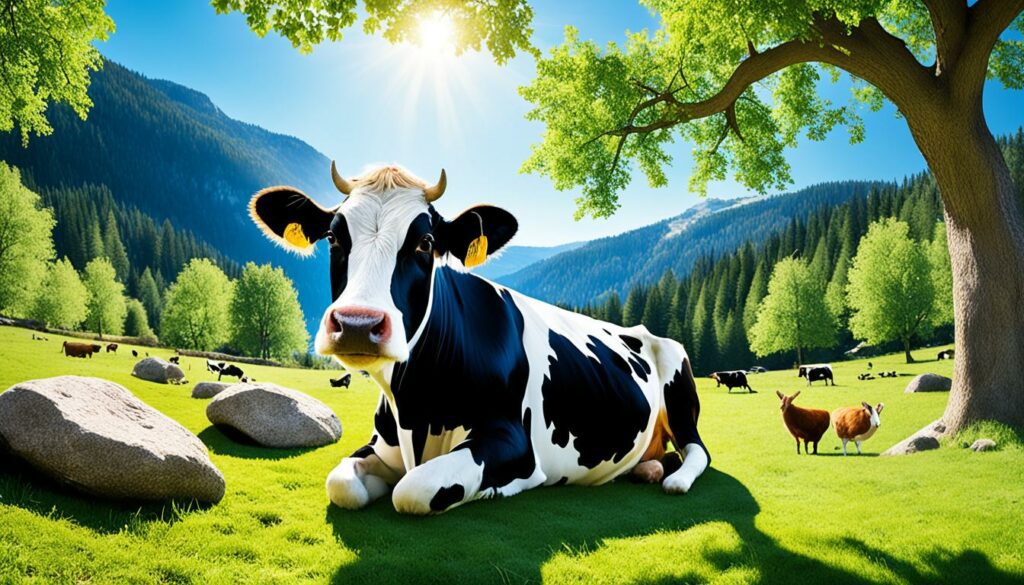
| Country | Main Livestock System | Stress Mitigation Strategies |
|---|---|---|
| New Zealand | Grass-based dairy farming | Adaptive management, increased grazing, minimal concentrate feeding |
| Pennsylvania, USA | Grass-based dairy farming | Improved cow health, operational efficiencies, feed management |
| Tanzania | Agro-pastoral and pastoral systems | Resource-efficient grazing, water management, disease control |
Key to happier, healthier herbivores is good access to pasture, right food, and making them easy to handle. Crafting a smart plan for the local environment and animal needs ensures success in pasture farming. It helps to lower stress levels, which is good for the animals and the farm.
We’ve covered a lot about how to manage stress in livestock. The key is to use many different methods. This includes defining stress and its causes, improving animal care, bettering the environment, giving good food, and handling animals well.
Vaccinating cattle against bovine herpesvirus 1 significantly cuts abortion rates. Quiet handling methods at places like Texas feedlots and Reeve Cattle Co. have made cattle healthier. This also gets them back to eating faster, which boosts how much they produce. It’s clear that reducing stress, like stopping the use of electric prods, has big rewards.
Choosing the right food and preventing diet issues are also helpful. They improve cattle’s health and how well they can have babies. For instance, feeding them right keeps them from losing weight and makes their immune systems stronger. Teaching animals to be calm during care helps too, making pigs in Japan less stressed and better for selling.
Putting all these methods together can really lower stress in livestock. Treating animals well means not only are they happier, but farms can be more successful and kind to our planet. Our goal is to create a farming environment that’s as stress-free as possible, for the good of both the animals and us.
Livestock get stressed from things like getting hurt, changes in their surroundings, and being around new people. They often react with either ‘fight’ or ‘flight’. This makes their bodies produce adrenaline and noradrenaline.
Stress makes animals eat less and stops some hormones that are good for them, like oxytocin. These effects cause animals to have less babies, get sick more often, and be less productive on farms.
Being gentle and quick with animals, using proper facilities, and avoiding pain are good ways to handle them. This approach helps keep animals calm and healthy.
Improving their living space helps. This means making sure they are not too hot or cold, have a good place to sleep and fresh air, and using modern methods for milking and grooming. This all lowers how much they interact with people, which can be stressful for them.
Feeding them the right things can make a big difference. For instance, giving them special food when it’s too hot or too cold helps lower their stress. This also makes farm life run more smoothly.
Approaching them kindly and making sure they don’t feel pain are key. These steps can make medical procedures less stressful for animals. They can also help animals stay peaceful afterwards.
Getting animals used to people when they’re young, and caring for them the same way every day, makes them feel safe. This reduces how much they stress when handling or changes occur.
Adding specific foods and energy during weaning and lactation helps. This makes changes easier and keeps the animals healthier. It’s important for a smooth farm cycle.
It’s critical to keep an eye on the weather conditions and do things like providing shade, good airflow, and water to manage heat stress. This helps keep animals cool and comfortable.
Planning ahead of time, knowing the animals’ health and feeding history, and giving them time to rest and eat well after travel can help reduce stress. These steps are essential for peaceful journeys.
Robots for milking and grooming let animals choose when to do these activities. This lessens the need for people to handle them, which, in turn, reduces their stress and keeps them calm.
Good farm management focuses on the environment, what animals eat, how they’re handled, regular routines, and new technology. Such a plan aims to reduce stress and improve the happiness and work rate of livestock.
Too many animals, poorly managed food, and discomfort can stress herbivores on fields. Making sure they have enough space, food, and a comfortable place to rest helps lower this stress and keeps them healthy.